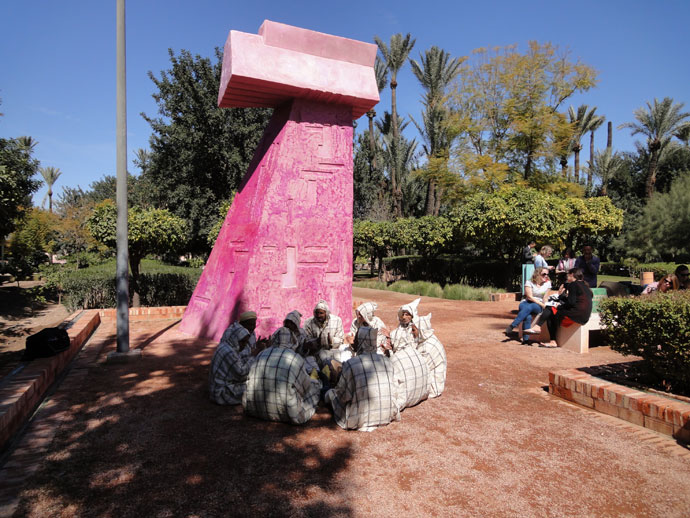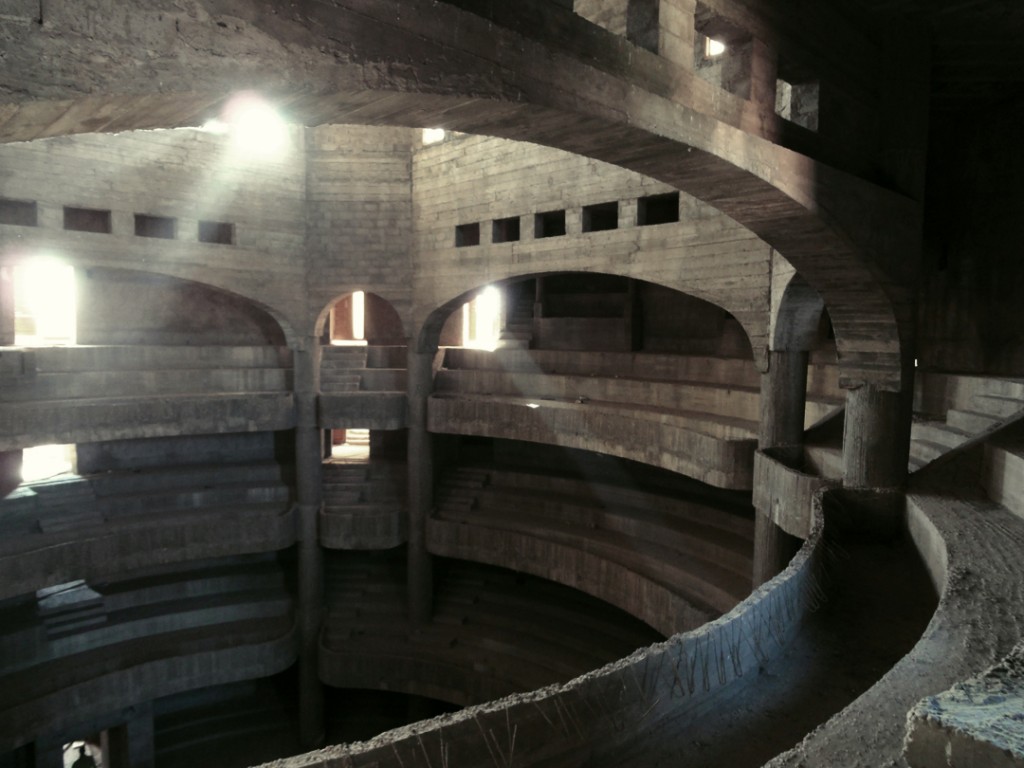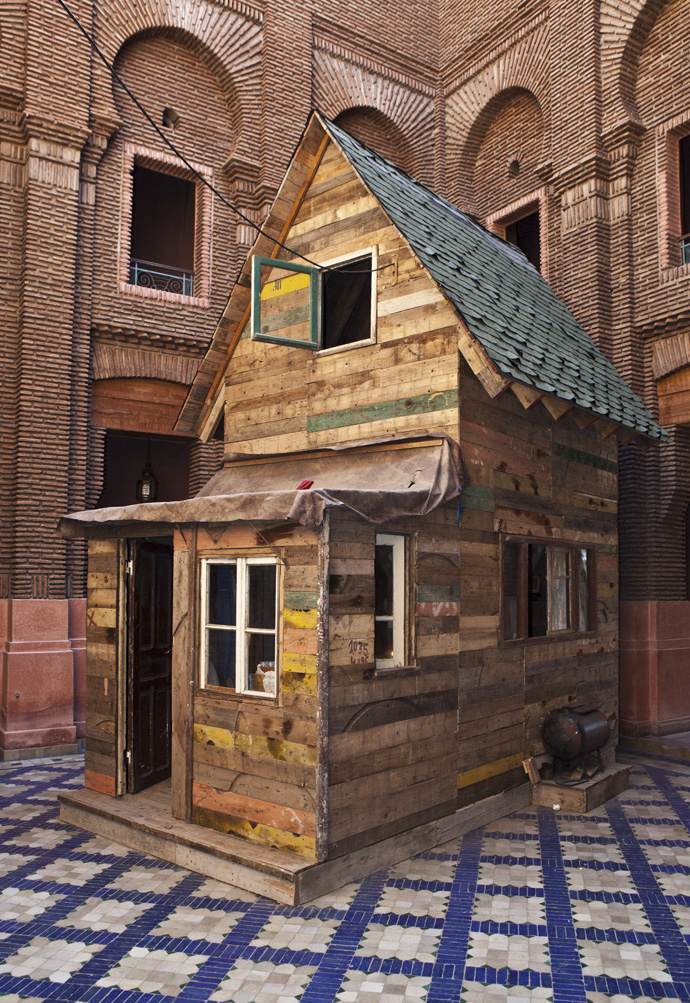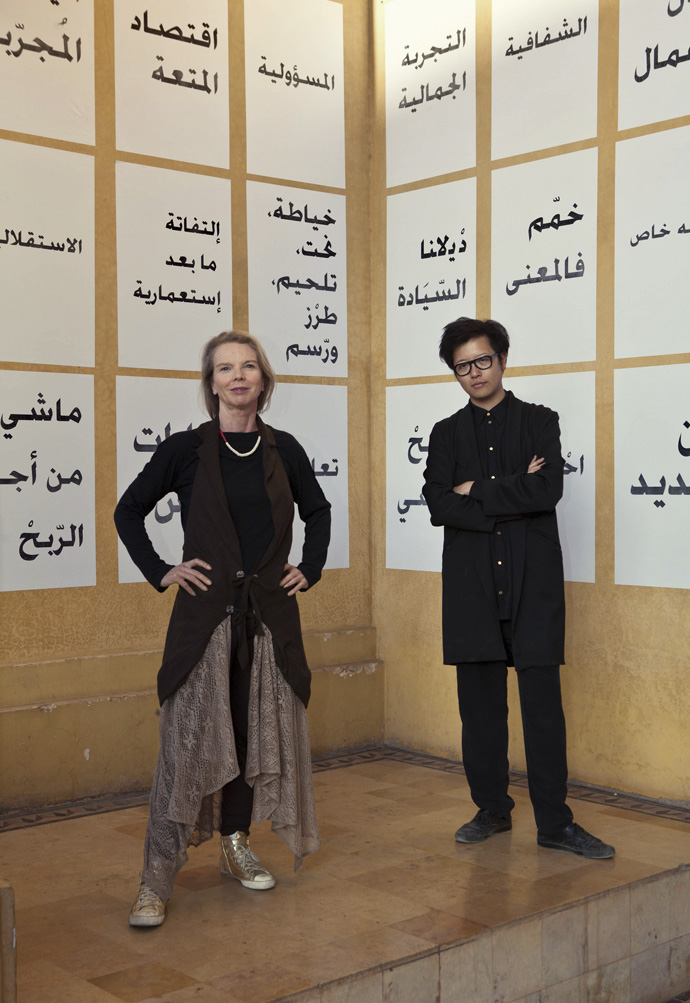-

HIGHER ATLAS – Marrakech Biennale
-The Arab Spring.One year later, the events seem so distant already, and yet an undeniable change has taken place in the atmosphere.
A special case: Marocco, where evolution, rather than revolution, is being encouraged through a revised constitution. And now, the Marrakech Biennale, HIGHER ATLAS, curated by Carson Chan and Nadim Samman under the patronage of Vanessa Bronson, opens its door.
A special case, a special place, in a special time… an interview with curator Carson Chan.
The Théatre Royal, under construction.
How was lunch?
Thanks for asking! There’s been little time for lunch these days, but the 6 dirham omelets across from one of exhibition sites, the Théâtre Royal, are great.Now that you spend so much time in Marrakech- what are your favorite places you hang out to get a fresh head?With my indispensable curatorial assistant, Marie Egger, we often duck away for an hour at the Cafe de la Poste, a beautiful colonial-era restaurant.
Did you accustom to the local rhythm?It took a few weeks, but I think I finally got a hang of how to deal with contractors, suppliers, interns, accountants and bureaucracy in Marrakech. This time around, I’ve been here for more than a month, and it’s been great to become familiar with some of the people in my neighbourhood. That being said, I’m still often my own tourist attraction!
So did you surrender? Or is it the other way around?I think everyone involved has surrendered to the biennial making process. I knew that logistics would be a challenge, but in the end, the exhibition, often spectacular, sometimes very quiet, was curated to appeal first and foremost to the senses.
How did your engagement with the Marrakech biennale and Nadim Samman come together?We were invited December 2010. I ended up meeting Vanessa Branson, the president of the Arts in Marrakech foundation at Art Basel Miami, and was hired after a brief presentation of my past exhibitions on my ipad! She had met Nadim a month earlier in London at an exhibition he made there.
You had initially planned the El Badi palace to be at the core of the Higher Atlas biennale. As I understand one of the challenges you faced with the change of administration was that at some point El Badi was no longer available. What were the consequences?The consequences of losing the El Badi palace was pretty great in the end! The show now spans five different sites in and around Marrakech, so when traveling from one location to another, visitors, both local and from abroad, will begin to see the city as part of the context of the exhibition.
The Théâtre Royal, a half completed opera house commissioned by King Hassan II, the old foundations and underground cisterns of the sacred Koutoubia Mosque, the so-called Cyber Park (it’s owned by Moroc Telecom and has perhaps the best wifi in the city!), the Bank al-Maghrib building in the historic Djemaa el-Fna square as well as an large scale sculptural installation by Elin Hansdottir in the town of Tassoultante about 15km outside of the city are all places where we have exhibitions.
Particularly in the urban public spaces like the square, the park and Koutoubia, it has been amazing to see visitors that have had very little exposure to contemporary art stay and take time to experience the work.
Installation by Ethan Hayes-Chute.
Did the “arab spring” affect you curating this project?The so-called Arab Spring (no one here would ever associate any kind of political unrest as a problem relating to other countries…) was definitely on my mind when I started conceptualizing the exhibition. Before spending time at in Marrakech, all I knew of Morocco was what I read about in the media – a politics biased reading if anything. The very fact that we made an exhibition of contemporary culture was a response to politic-heavy understanding of North Africa.
People here go shopping, go to restaurants, read books, watch movies and use the internet for YouTube just like everywhere else.
One of the biennales goals are articulating the blurred boundaries between historically discrete spheres, and the conjunction of local and global conditions. Which works would you allocate to this specific target, and how do you see their relevance?I would say Jon Nash’s work, Moroccan Drift, is a good example. When he was researching Morocco online, he came across several drift videos in which people would speed up their cars and turn in such a way that the car moves sideways. Inspired by Tokyo drift and other videos from around the world, young Moroccans made their own Moroccan drift videos.
In the end, it was the space opened up by the Internet, not, say, geo-politics, that shaped the cultural lives of the Moroccans making these videos. Morocco is used by filmmakers as stand-ins for several other places. Ridley Scott shot Prince of Persia here, and of course Morocco is no where near Persia. Large HDI balloons are often used as stand ins for the moon, and American artist, Karthik Pandian, decided to launch one of them in the Djemaa el-Fna square for one night. On that night, March 2nd, Marrakech had two moons, the real one, and the one Karthik launched, which was cubic in shape – a gigantic white cube, as it were.
Was it difficult for you to get rid of the post-colonial shades and orientalist romanticism?Post-colonialism and its echos are definitely here, but not unlike other cities like Hong Kong, Montreal or Mexico City. We worked with about 50 university students from the Cadi Ayyad University, and they definitely regard themselves as either Moroccan or simply world citizens, not products of post-colonialism. In fact, I consciously tried to bypass this framework by foregrounding art as a question of physical experience, rather than a communicator of historical conditions. Having said that, Leung Chi Wo, from Hong Kong, reflected on post-colonial identities in his work.
Right, Carson Chan, co-curator, and left, Vanessa Bronson, biennale founder.
I am curious to hear a little on the locals reactions in this context?The local reaction so far has been amazing! If anything, it has really gotten people talking. Thousands came to our opening, and we are being featured in the local media – radio, television, newspaper, magazines – on a daily basis. Our interns, who have worked for the past two months alongside myself and our artists, are our main ambassadors. They tell people on the street, friends, make their own ads and posters about the show.
I went to check up on the Koutoubia exhibition the other days and it was packed with people streaming in from the main square. At the Bank al-Maghrib, where Nine Eglantine Yamamoto-Masson curated video art as part of a walk-in screening room, I saw families sitting inside entranced by the videos.
How did you encounter the local support when approaching it?Not only do we have support from the mayor, the Wali of Marrakech and just recently the patronage of the King himself, the love and support we get from our contractors and workers has been immense. One contractor, Said Aakif, has been instrumental to the success of the biennale, and we’re all really grateful for his dedication.You recently halted your project PROGRAM in Berlin, what was the decision? And, in retrospect how do you see this curatorial experience has affected you?
Fotini Lazaridou-Hatzigoga and I ran PROGRAM for more than 5 years, and as a project that experimented in art and architecture exhibitions, we felt that we had had our run.There will definitely be more projects through PROGRAM, but the experience there has definitely shaped my work here in Marrakech. To start with, many of the artists I’ve shown there were also in the biennale.What are your plans after the Marrakech Biennale?I’m editing two magazines – editor at large for 032c, and contributing editor for Kaleidoscope – so that will take up much time. There are a few more exhibitions this year, talks and lectures, but I’m taking time to work on a conference at Yale University with David Tasman and Eeva Liisa Pelkonen about architecture exhibitions. There are a few books up my sleeve as well…
 Aleksandra Domanovic's "Monument to Revolution" and the al-Ghiwane singers,
performing turner-prize nominee Roger Hiorn's untitled performance.
Aleksandra Domanovic's "Monument to Revolution" and the al-Ghiwane singers,
performing turner-prize nominee Roger Hiorn's untitled performance.
What is the last thing that stimulated you?
The most stimulating thing was the exhibition vernissage. To see people experiencing the artworks I spent so much time thinking about and considering, to see them take it in and take their time, to see people encounter things they may never have encountered before, that has been the most stimulating.10


